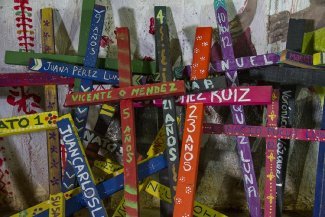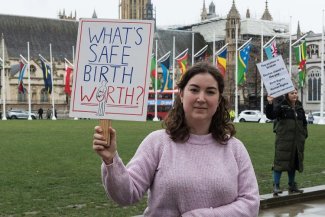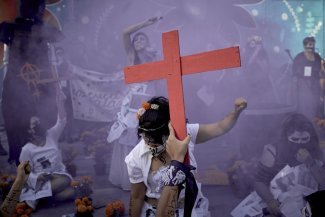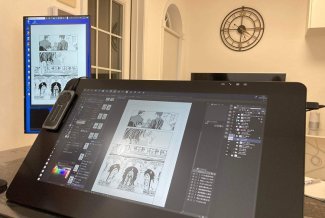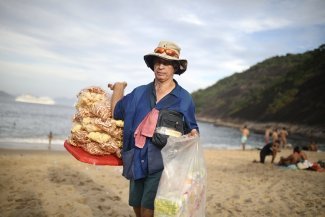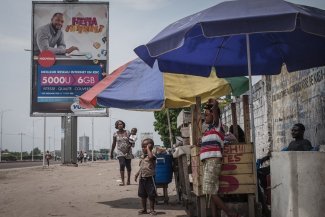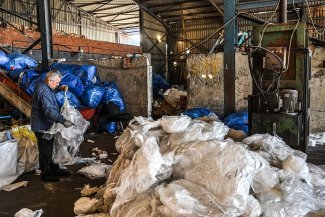Social leader Lucila Páez suffered violence and threats at the hands of the paramilitaries at the end of the 1990s. Here she is pictured in front of a mural on the building where her association is based in Norte de Santander, one of the areas facing renewed insecurity.
The assassination of human rights defenders is a plague that has been spreading in recent years. Latin America is the worst affected: 85 per cent of the killings recorded in 2017 (out of 312, in 27 nations) were concentrated in six countries, five Latin American (Colombia, Brazil, Guatemala, Honduras and Mexico), plus the Philippines, where 60 human rights defenders were assassinated, making it the most dangerous place outside of the Americas. Colombia is currently the deadliest place in the world for rights defenders.
At least one social leader has been killed every three days, on average, since the historic peace agreement signed at the end of 2016. “If someone were to speak out like me in Colombia, they would be killed,” said US film director Oliver Stone on the issue.
It seems paradoxical that a country managing to put an end to over half a century of war should become more dangerous for its citizens. The key is the underlying problem, the networks at the helm of drug trafficking and other businesses such as illegal mining continue to be controlled by powerful armed bands now operating under different names and banners.
“The inability of the Colombian state to fill the power vacuum left after the departure of the FARC guerrilla and the uncertainty generated by the new government of Ivan Duque, who opposed the peace agreement during the campaign, have created a more violent scenario that is more difficult to control,” according to several NGO representatives gathered in Bogotá in August by the European Commission.
The UN has reported that 259 human rights defenders and social leaders were murdered in the country between the year 2016 and 15 March 2018. According to the report Todos los nombres, todos los rostros (All the Names, All the Faces), published in May by Colombian community organisations, 385 activists and 63 former FARC guerrillas have been killed in less than three years.
Unnamed victims
This tragedy is not without names. But many of its victims prefer to remain anonymous, for fear that the threats they receive will be executed. This is the case of Laura (a pseudonym, at her request), a 34-year-old mother with three children, who has spent all her life struggling to get ahead in Catatumbo, one of the country’s trouble spots, a jungle-covered region bordering Venezuela.
Three years ago, she embarked on a collective reparation project with 50 other women who had been victims of the conflict. They secured 23 hectares of land where they grow bananas, maize, cassava and vegetables, as well as raising pigs and poultry. They are all single mothers, some with as many as seven children to look after.
Laura was tired of seeing the children from her village being forcibly recruited by illegal armed groups who use them to crush coca leaves, as informants and even as human shields in clashes with the army and other gangs. She also got tired of being locked up at home.
Within a few months, she was taken away by a group of armed men. “You have to speak to our commander.” The head of the armed gang accused her of being a police informant and of stirring up revolt within the community. “I’ve been warned that you’re a troublesome leader. We are watching you, we know that you have three children of such and such an age. If you do something we don’t like, you know what will happen.”
Laura has received more threats since then, which she has reported to government agencies such as the Victims’ Unit and the National Protection Unit. The only solution they offer her is to take her children and flee the area.
“If I leave now, everything I have done will have been a failure. If they kill me, at least my example will inspire other women,” she says.
History is also repeating itself in other parts of rural Colombia, where the armed conflict claimed so many lives and where the threats have escalated once again. Concern is growing in the country’s frontier regions, the departments bordering Venezuela (Norte de Santander, Arauca), Panama (Chocó and Antioquia) and Ecuador (Nariño, Putumayo).
Causes: defending minorities and the environment
Some 3,500 activists have been killed for denouncing injustice since 1998, when the United Nations adopted the Declaration on Human Rights Defenders. UN High Commissioner for Human Rights Michelle Bachelet has warned of the increase in numbers over recent years.
The causes are diverse, but there are patterns that repeat themselves. The NGO Global Witness already warned in 2016 that Latin America was the most dangerous place in the world for environment defenders.
Among the activists killed last year, 67 per cent were involved in environmental causes or defending access to land and indigenous peoples’ rights, almost always in the context of mega-projects linked to the extractive industry and big business, according to a report by the independent organisation Front Line Defenders.
The killings are being fuelled by a climate of impunity and the state’s inaction. Although the crimes were preceded by threats in 84 per cent of the cases, the justice system is painfully slow and the culprits are seldom identified. “In the vast majority of cases, no one has been convicted or even charged of these crimes,” says the executive director of the organisation, Andrew Anderson.
In countries like Colombia, the constant trickle of murders targeting social leaders has provoked a public outcry that reached the national congress in September. Members of the opposition are insisting that the government and institutions such as the Public Prosecutor’s Office need to take more action.
They are urging the Colombian state to recognise the parallels between what is happening now and the massacres seen during the late 1980s and the 1990s, targeting members of the Patriotic Union (UP), a left-wing party that emerged following the demobilisation of several guerrilla groups.
“I feel the same today as I did 25 years ago when we were being shot down on the streets every day. I’m reliving those terrible nights again, when people would call us from one department or the other to tell us someone had just been killed,” says Aída Avella, national president of the UP, who pointed to a connection between the perpetrators and state agents in an interview with the Colombia daily El Espectador.
“The authorities must take urgent action to determine who is behind this savagery,” says the new conservative president, Ivan Duque. Interior Minister Nancy Patricia Gutiérrez however refuses to recognise the systematic nature of the killings.
There is an underlying question that has as yet to be answered in Colombia: were the far-right paramilitary groups truly dismantled following the demobilisation completed by former president Álvaro Uribe in 2006?
Looking to the future
Lucila Páez suffered in the flesh from paramilitary violence in Colombia in the late 1990s. This 60-year-old woman, who welcomes Equal Times with a smile into her home in El Zulia (a municipality in Norte de Santander), has lived much of her life in fear. She needs to tell her story to try to put it behind her and overcome it. She has been accused of being a guerrilla, she was harassed and intimidated, but continued, in spite of everything, with her work to empower the community. She refused to be silenced.
“We peasant women are demanding that we be left to work in peace,” she says with determination in front of a mural on the building where her association is based. “Our aim is to build peace, to bring productive projects to the regions, so that we have what we need to survive.”
This woman went through what Laura is suffering today in nearby Catatumbo. It has been some time since she received threats, but she can sense the anxiety and the rise in insecurity. “I hope we never go back to the time of the massacres and chainsaw dismemberments,” she insists.
Others like her are trying to do their bit, however they can, even through the cultural scene.
“We cannot allow them to prohibit our pain and our anger. We cannot allow ourselves to stop going out onto the streets to march as many times as need be to protest against the deaths of our friends and colleagues,” says Alí Majul, a member of the Contextos collective, who works on social projects in the poor neighbourhoods of Cartagena de Indias.
Majul tattoos a black dot on his back for every social leader killed. The activist uses his body to denounce the pain within Colombian society. In one of his performances, he sat in a basin full of ice for more than an hour. It was a metaphor for the insensitivity that has permeated his country. “After years numbed by the noise of war, Colombia is no longer hurt by anything,” he explains
These struggles also find an echo in the demonstrations faced with repression in Venezuela or Central American countries such as Nicaragua, or by the Mexican journalists who continue to denounce the drug lords, despite the threats, or the environment defenders in Brazil. In Colombia, these collectives have taken the slogan “Not one more” and made it their own.




